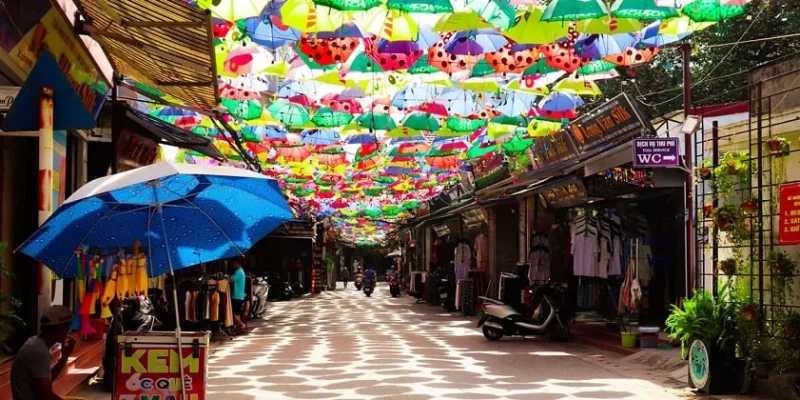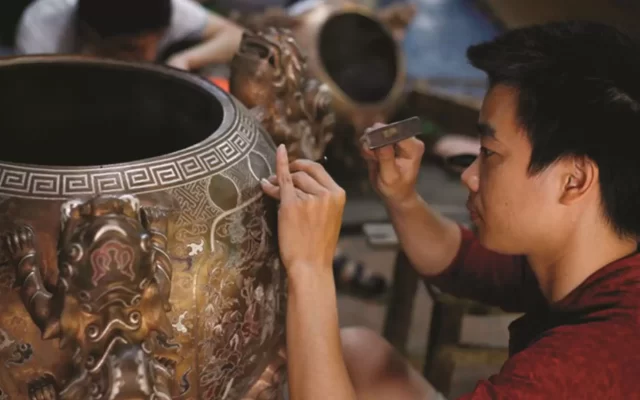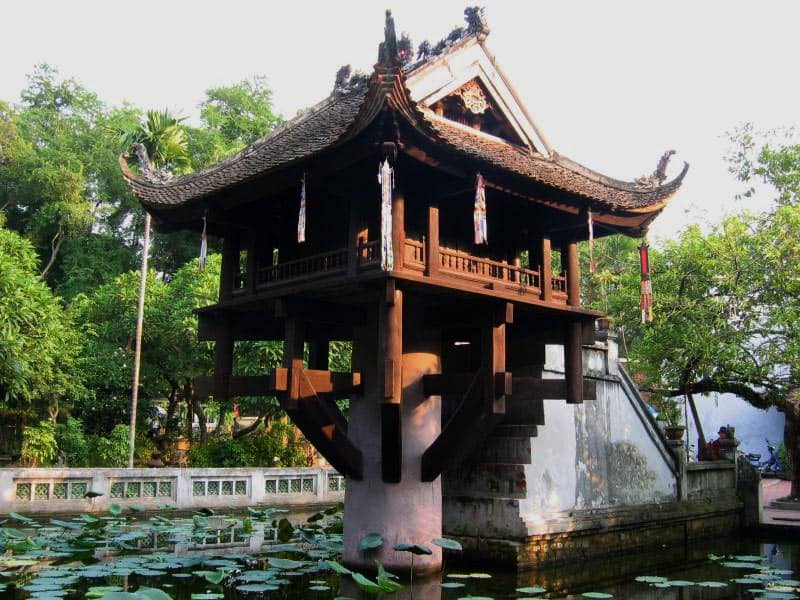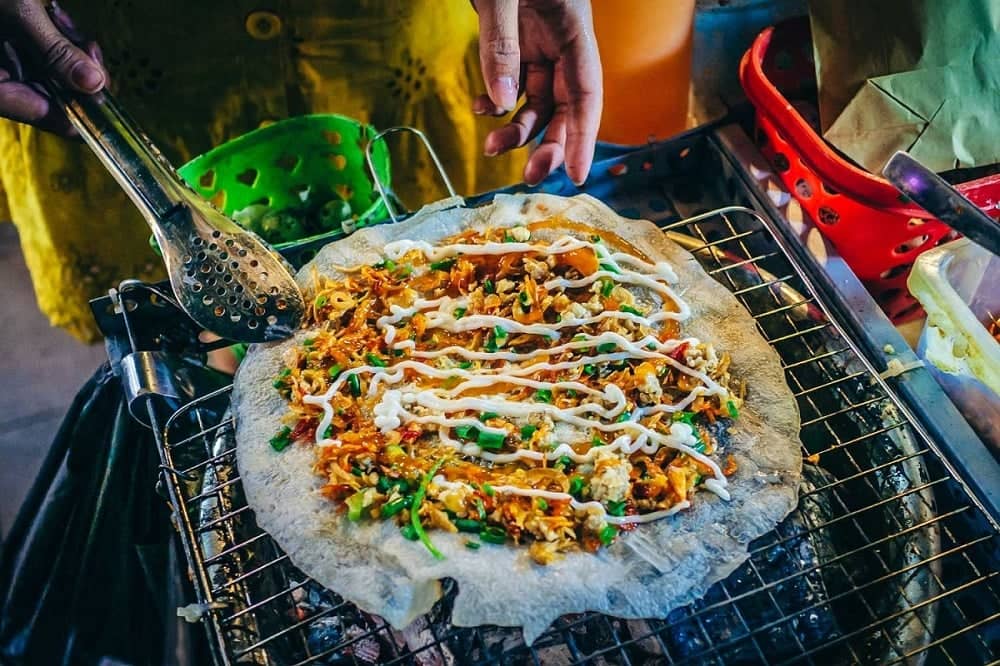
Let’s explore the cultural beauty of Hanoi
Explore the rich tapestry of Hanoi culture with our comprehensive guide. Discover historical landmarks like the UNESCO-listed Imperial Citadel of Thang Long, delve into traditional festivals and cuisine, and immerse yourself in the city’s vibrant arts scene. Uncover the essence of Vietnam’s capital through its traditions, modern art, and local customs.
I. Introduction to Hanoi Culture
1. Overview of Hanoi

Hanoi Old Quarter
Hanoi, the capital of Vietnam, is a city that seamlessly blends the old with the new. Situated in the northern region of the country, Hanoi is not only a political center but also a cultural and historical hub.
The city’s rich history spans over a thousand years, beginning with its establishment as the capital of Vietnam under the name Thang Long in 1010. Hanoi’s streets are a living museum of the past, with French colonial architecture, ancient pagodas, and bustling markets that reflect its diverse cultural influences.
2. The Role of Hanoi in Vietnamese Culture
Hanoi holds a significant position in the cultural landscape of Vietnam. As the capital, it has been the heart of Vietnamese political, cultural, and historical events for centuries. The city is a treasure trove of cultural heritage, housing numerous historical monuments, ancient temples, and cultural sites that narrate the story of Vietnam’s past.
II. Hanoi Cultural Heritages
1. World Cultural Heritage Sites
Hanoi is home to several UNESCO-recognized cultural heritage sites that reflect its historical and cultural significance.

Imperial Citadel of Thang Long
The Imperial Citadel of Thang Long, which was recognized as a UNESCO World Heritage Site in 2010. This ancient site, dating back to the 11th century, served as the political center of the Ly, Tran, and Le dynasties. Excavations have revealed artifacts and structures that provide invaluable insights into the city’s historical evolution, including palaces, ancient roads, ponds, and wells.

Hanoi Old Quarter
The Temple of Literature, established in 1070, is another cultural gem, originally built as a temple to honor Confucius. It later became Vietnam’s first university, the Imperial Academy, where scholars studied the principles of Confucianism, literature, and poetry.
2. Ancient Architectural Works
Hanoi’s architectural landscape is dotted with ancient buildings that have stood the test of time, offering a window into the city’s rich past.
Traditional Vietnamese houses in the Hanoi Old Quarter, characterized by their narrow, tubular structures, showcase a blend of indigenous and colonial architectural styles. These houses often have courtyards and are adorned with intricate wood carvings.

One Pillar Pagoda
Temples and pagodas are integral to Hanoi’s spiritual and cultural fabric.
- The One Pillar Pagoda, built in 1049, is one of Vietnam’s most iconic Buddhist temples, designed to resemble a lotus blossom rising from the water.
- The Tran Quoc Pagoda, located on the West Lake, is the oldest Buddhist temple in Hanoi. It was originally constructed in the 6th century, during the Ly Nam De Dynasty.
Click here: Hanoi Day Trip
III. Customs and Traditions of Hanoi Culture
1. Lunar New Year (Tet)

Tet holiday in Hanoi
Traditional Rituals and Unique Customs: Tet is the most significant and widely celebrated festival in Vietnam, marking the lunar new year. It is a time for family reunions, paying respects to ancestors, and starting the new year with renewed vigor and positivity. Traditional rituals include:
- Cleaning and decorating the house: Homes are thoroughly cleaned and adorned with peach blossoms, kumquat trees, and red decorations symbolizing good luck.
- Offering food to ancestors: Families prepare lavish meals and offer them on ancestral altars, accompanied by incense burning to invite deceased family members to join the celebration.
- Giving and receiving “li xi” (lucky money): Elders give red envelopes containing money to children and younger family members as a symbol of good fortune and prosperity.
- New Year’s Eve celebration: Families gather for a feast and stay up late to welcome the new year, often marked by fireworks and traditional music.
2. Hanoi Traditional Festivals
Hung Kings’ Temple Festival

Hung Kings’ Temple Festival
Held annually on the 10th day of the third lunar month, this festival honors the Hung Kings, the legendary founders of Vietnam.
Thousands of pilgrims travel to the Hung Temple in Phu Tho Province to participate in various activities, including processions, incense offerings, traditional games, and cultural performances. The festival is a testament to Vietnamese people’s reverence for their ancestors and their deep-rooted historical identity.
Perfume Pagoda Festival

Perfume Pagoda Festival
Taking place from the 6th day of the first lunar month to the end of the third lunar month, the Perfume Pagoda Festival is one of the largest Buddhist pilgrimages in Vietnam. Pilgrims travel to the Perfume Pagoda, located in the My Duc District of Hanoi, to pray for health, prosperity, and happiness.
The journey involves a scenic boat ride along the Yen Stream and a hike up to the pagoda, where visitors can participate in religious ceremonies, explore caves, and enjoy traditional Vietnamese folk music.
Co Loa Festival

Co Loa Festival
Celebrated in the Co Loa Citadel in Dong Anh District, Hanoi, this festival commemorates King An Duong Vuong, the founder of the ancient Au Lac Kingdom.
Held annually on the 6th day of the first lunar month, the festival features traditional processions, incense offerings, and various folk games such as wrestling, tug-of-war, and cockfighting. The Co Loa Festival is a vivid reflection of Vietnam’s historical and cultural heritage.
Learn more about: Hanoi Festivals
3. Hanoi Traditional Cuisine
Hanoi cuisine is an integral part of its cultural identity, offering a rich tapestry of flavors and culinary techniques. Some must-try specialty dishes include:
- Pho: Hanoi is renowned for its pho, a fragrant noodle soup consisting of broth, rice noodles, herbs, and meat (usually beef or chicken). Pho is typically enjoyed as a breakfast dish and is celebrated for its clear, flavorful broth and tender meat.
- Bun Cha: This iconic Hanoi dish features grilled pork patties and slices served with a side of vermicelli noodles, fresh herbs, and a dipping sauce made from fish sauce, lime juice, sugar, and chili. Bun Cha is traditionally enjoyed at lunchtime and is often accompanied by fried spring rolls.
- Cha Ca La Vong: A unique and delectable dish, Cha Ca La Vong consists of grilled fish marinated in turmeric and dill, served with rice noodles, peanuts, herbs, and a special shrimp paste sauce. This dish is so famous that a street in Hanoi’s Old Quarter is named after it.
Read more: Hanoi Street Food
IV. Religion and Beliefs in Hanoi Culture
Hanoi is a melting pot of various religions and beliefs, with Buddhism being the most prominent.
1. Buddhism in Hanoi

Tran Quoc Pagoda is one of the symbols of Buddhism in Hanoi
Buddhism plays a significant role in the spiritual life of Hanoi’s residents. It was introduced to Vietnam in the 2nd century and has since become deeply embedded in the culture. The city is home to numerous ancient pagodas and temples, each with its own unique history and architectural beauty.
- One Pillar Pagoda: This iconic Buddhist temple was originally built in 1049 during the reign of Emperor Ly Thai Tong. Its unique structure, resembling a lotus blossom, symbolizes purity and is considered one of Hanoi’s most famous landmarks.
- Tran Quoc Pagoda: Located on a small island in West Lake, this is one of the oldest pagodas in Vietnam, dating back over 1,500 years. It’s renowned for its stunning architecture and serene setting.
- Perfume Pagoda: A vast complex of Buddhist temples and shrines built into the limestone Huong Tich mountains. This site is a popular pilgrimage destination, especially during the Perfume Pagoda Festival.
2. Major Religious Festivals in Hanoi

Quan Thanh Temple Festival
Hanoi hosts numerous religious festivals throughout the year, reflecting its rich cultural tapestry.
- Perfume Pagoda Festival: One of the largest Buddhist festivals in Vietnam, it attracts pilgrims and tourists alike. Held from the 6th day of the first lunar month to the end of the third lunar month, the festival includes a pilgrimage to the Perfume Pagoda, prayers, and traditional performances.
- Phu Tay Ho Festival: Celebrated at Tay Ho Temple, this festival honors Princess Liễu Hạnh, a revered figure in Vietnamese folk religion. The festival, held on the 15th day of the first lunar month, includes traditional rituals, music, and dance.
- Quan Thanh Temple Festival: This festival is held at Quan Thanh Temple, dedicated to Trấn Vũ, one of the principal deities in Taoism. Celebrated on the third day of the third lunar month, it features ceremonial offerings, martial arts demonstrations, and cultural performances.
3. Traditional Folk Beliefs
In addition to organized religions, Hanoi is rich in traditional folk beliefs, which have been passed down through generations.
- Ancestor Worship: This is a fundamental aspect of Vietnamese spiritual life. Families maintain ancestral altars in their homes, where they make offerings to deceased relatives, seeking their blessings and protection.
- Mother Goddess Worship: This belief system honors the Mother Goddesses of Heaven, Earth, and Water. The practice includes rituals, festivals, and spirit possession ceremonies. Phu Tay Ho in Hanoi is a significant site for this worship.
- Folk Heroes and Deities: Many local temples and shrines are dedicated to historical figures, mythical heroes, and deities who are believed to protect the land and its people. For example, the Temple of Literature not only honors Confucius but also serves as a place to venerate scholars and educators.
V. Hanoi Traditional Craft Villages
Hanoi is renowned for its vibrant craft villages, where centuries-old traditions are preserved and passed down through generations. Visiting these villages offers a unique glimpse into the artisanal heritage of Vietnam and an opportunity to witness skilled craftsmen at work.
1. Bat Trang Pottery Village

Bat Trang Pottery Village
Bat Trang Pottery Village, located along the banks of the Red River, is a treasure trove of Vietnamese ceramic artistry. With a history dating back over 500 years, this village is famed for its exquisite pottery, characterized by vibrant glazes and intricate designs. Visitors can witness traditional techniques such as wheel-throwing, glazing, and firing in centuries-old kilns.
The village’s offerings range from functional pottery like vases, bowls, and teapots to decorative art pieces, each showcasing the unique craftsmanship and heritage of Bat Trang. A visit here not only allows you to purchase authentic pottery but also provides a chance to engage in hands-on pottery-making workshops, making it a must-visit destination for art lovers and cultural enthusiasts..
2. Van Phuc Silk Village

Van Phuc Silk Village
Van Phuc Silk Village, situated on the banks of the Nhue River, is renowned for its silk weaving, a craft that has thrived for over a thousand years. The village’s artisans are masters in the art of silk weaving, producing high-quality fabrics with intricate patterns and rich textures.
Visitors can explore the traditional silk-making process, from silk worm breeding and cocoon extraction to weaving and dyeing, using both traditional and modern techniques.
The village is famous for its silk garments, scarves, and accessories, known for their softness, sheen, and durability. A stroll through Van Phuc offers not only a glimpse into this ancient craft but also the opportunity to purchase beautiful, handwoven silk items, making it a quintessential stop for anyone interested in Vietnamese textiles.
3. Ha Thai Lacquerware Village

Ha Thai Lacquerware Village
Ha Thai Lacquerware Village, nestled on the outskirts of Hanoi, is celebrated for its distinctive lacquerware, a craft with a history of over a thousand years. The artisans here use traditional methods to create stunning lacquered items, involving multiple layers of lacquer applied over wood, bamboo, or metal, and then meticulously hand-painted with intricate designs.
The village’s products range from everyday items like trays and boxes to exquisite pieces of art and furniture, often adorned with elaborate gold leaf inlays and vibrant colors. Ha Thai lacquerware is known for its durability and unique aesthetic, reflecting the deep cultural heritage and artistic skills of its creators.
Visitors can tour workshops, watch artisans at work, and even participate in lacquerware painting classes, making Ha Thai a fascinating destination for those interested in traditional Vietnamese crafts.
4. Ngu Xa Bronze Casting Village

Artisans at Ha Thai Lacquerware Village
Ngu Xa Bronze Casting Village, located in the heart of Hanoi, is renowned for its ancient bronze casting tradition, which dates back to the 11th century. The village’s artisans are skilled in the ancient art of lost-wax casting, creating a range of items from religious statues and ceremonial objects to modern sculptures.
The process involves intricate molding, casting, and finishing, resulting in pieces of exceptional detail and quality. Ngu Xa’s bronze works are not only functional but also serve as important cultural and religious artifacts, often featuring intricate engravings and motifs.
A visit to Ngu Xa provides an immersive experience into the craftsmanship and history of bronze casting, with opportunities to see artisans at work and purchase unique, handmade bronze items that showcase the village’s rich artistic legacy.
VI. Art and Music in Hanoi Culture
1. Traditional Music
Hanoi’s traditional music is a rich tapestry of sounds and stories that reflect the city’s deep cultural roots. Three prominent forms of traditional music are Quan ho, Ca tru, and Cheo.

Quan Ho singing often appears at village festivals
Quan Ho: Originating from the northern provinces of Bac Ninh and Bac Giang, Quan họ is a form of folk music that has been recognized as an Intangible Cultural Heritage by UNESCO. Quan ho is often performed during festivals and special occasions, where singers wear traditional attire, adding to the cultural experience.
Ca Tru: With over a thousand years of history, Ca tru is a genre of Vietnamese chamber music that combines poetry and music. Historically performed in royal courts and during scholarly gatherings, Ca tru’s complex rhythms and haunting melodies create an enchanting atmosphere.
Cheo is a form of traditional Vietnamese opera, with roots dating back to the 10th century. It combines music, dance, and comedic sketches to tell stories that often carry moral and social messages. Performed in open-air markets, village festivals, and modern theaters, Cheo remains a beloved art form for many Hanoians.
2. Water Puppetry

Water Puppetry is only available in Vietnam
Water Puppetry is a traditional Vietnamese art form that dates back to the 11th century in the Red River Delta region. This unique performance art takes place on a water stage where wooden puppets, controlled by puppeteers hidden behind a bamboo screen, gracefully glide across the water’s surface.
The puppetry depicts scenes from rural life, folklore, and legends, accompanied by live traditional music played on authentic instruments such as drums, flutes, and cymbals. Water Puppetry not only entertains but also preserves Vietnam’s cultural heritage, showcasing the ingenuity and creativity of its craftsmen.
The performances are a delightful blend of skillful puppet manipulation, vibrant storytelling, and lively music, offering audiences an immersive experience into Vietnam’s rich traditions and folklore. Today, Water Puppetry continues to enchant both locals and visitors alike, making it a beloved cultural treasure and a must-see attraction for anyone exploring Vietnam’s artistic heritage.
VII. Suggested Hanoi Cultural Attractions
1. Historical Sites
- Imperial Citadel of Thang Long, dating back over a thousand years, served as the political center of Vietnam for several dynasties. This UNESCO World Heritage site features well-preserved archaeological relics, ancient palaces, and fascinating insights into Vietnam’s feudal history.
- The Temple of Literature, Vietnam’s first national university, embodies the Confucian reverence for learning. Established in 1070, it honors scholars and sages and is renowned for its serene courtyards, pavilions, and stelae bearing the names of exceptional scholars throughout the centuries.
2. Museums
- The Vietnam National Museum of History showcases Vietnam’s history from prehistoric times to the present day. Its extensive collection includes artifacts from the Dong Son culture, Cham artifacts, and exhibits on Vietnamese history, archaeology, and ethnology.
- The Vietnam Museum of Fine Arts is a treasure trove of Vietnamese visual arts, featuring both traditional and contemporary works. Established in 1966, the museum houses a diverse collection of paintings, sculptures, and decorative arts, highlighting Vietnam’s rich artistic heritage.
3. Old Quarter and Craft Villages
- Hanoi Old Quarter, a labyrinth of narrow streets and alleys, is a vibrant hub of culture, commerce, and traditional architecture. Known for its bustling markets, ancient temples, and colonial-era buildings, it offers a glimpse into the daily life of Hanoians through the centuries.
- Bat Trang Pottery Village, located on the banks of the Red River, is renowned for its centuries-old tradition of pottery making. Visitors can explore workshops where artisans produce exquisite ceramics using traditional techniques, making it an ideal place to admire and purchase unique pottery pieces.
- Lan Ong Street in the Hang Trong Folk Painting Village is celebrated for its preservation of traditional folk art. Here, visitors can witness artisans meticulously handcrafting vibrant folk paintings that depict scenes from Vietnamese folklore and daily life, showcasing the country’s cultural heritage.
In conclusion, Hanoi’s rich cultural tapestry offers a captivating journey through history, traditions, and artistic expressions. From ancient temples and vibrant festivals to the thriving contemporary arts scene, Hanoi invites visitors to immerse themselves in a city where past and present coexist harmoniously.
Whether exploring historic landmarks, indulging in local cuisine, or experiencing traditional performances, Hanoi promises an enriching cultural adventure that leaves a lasting impression.




























